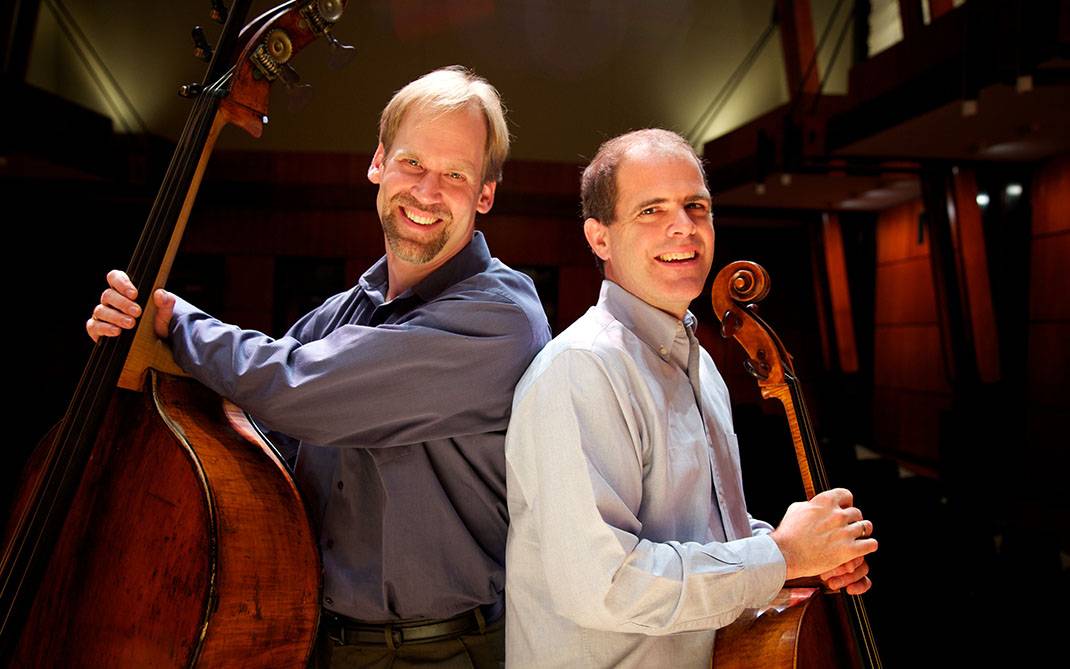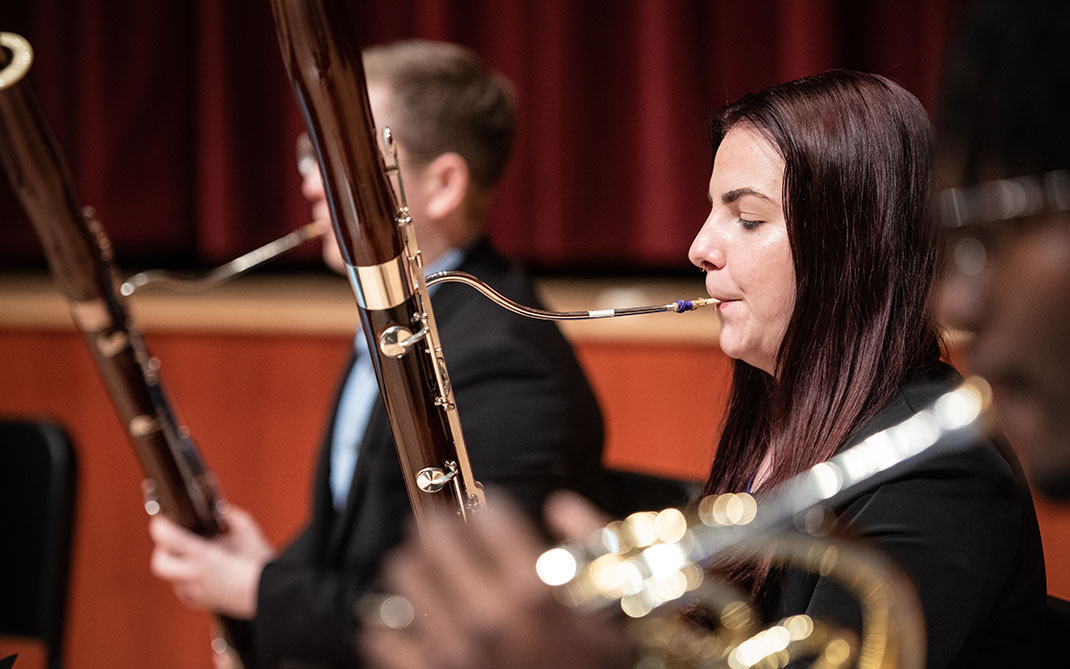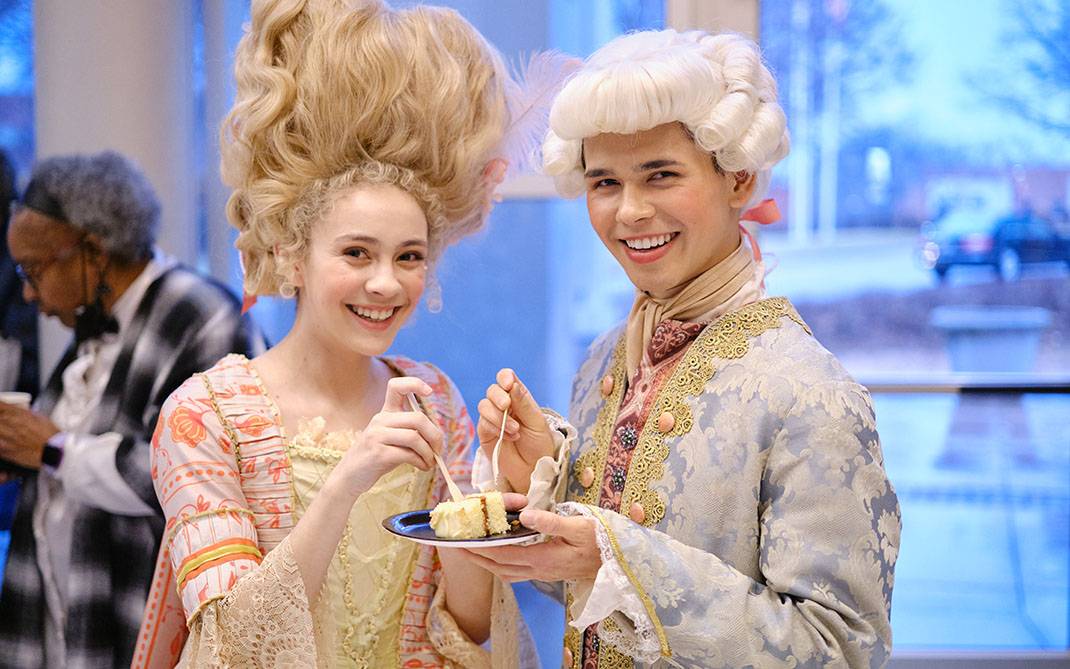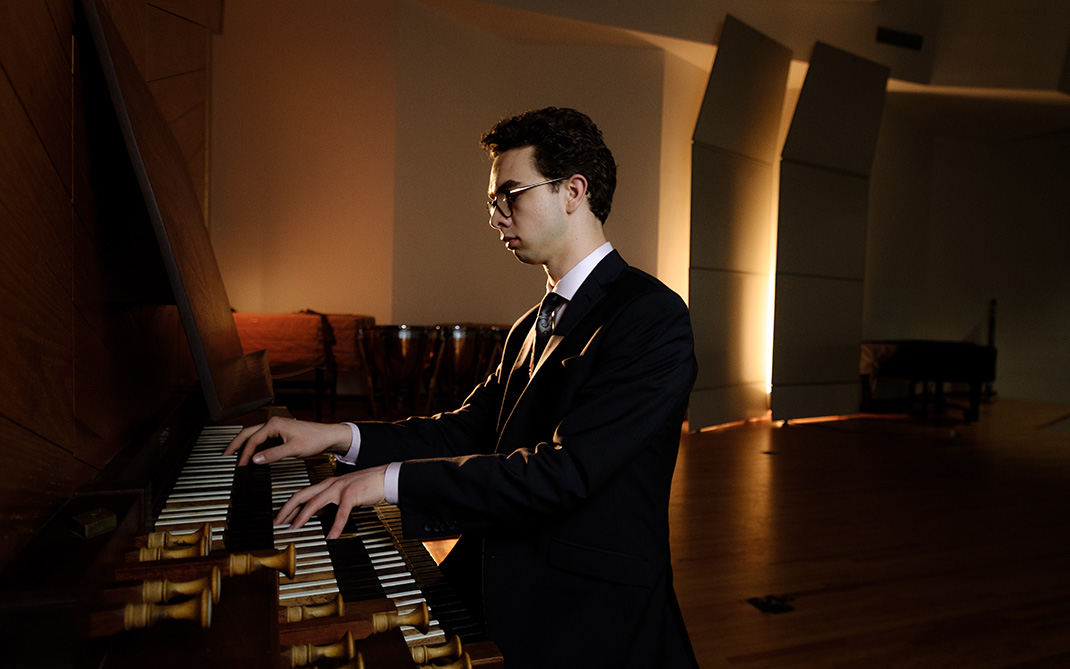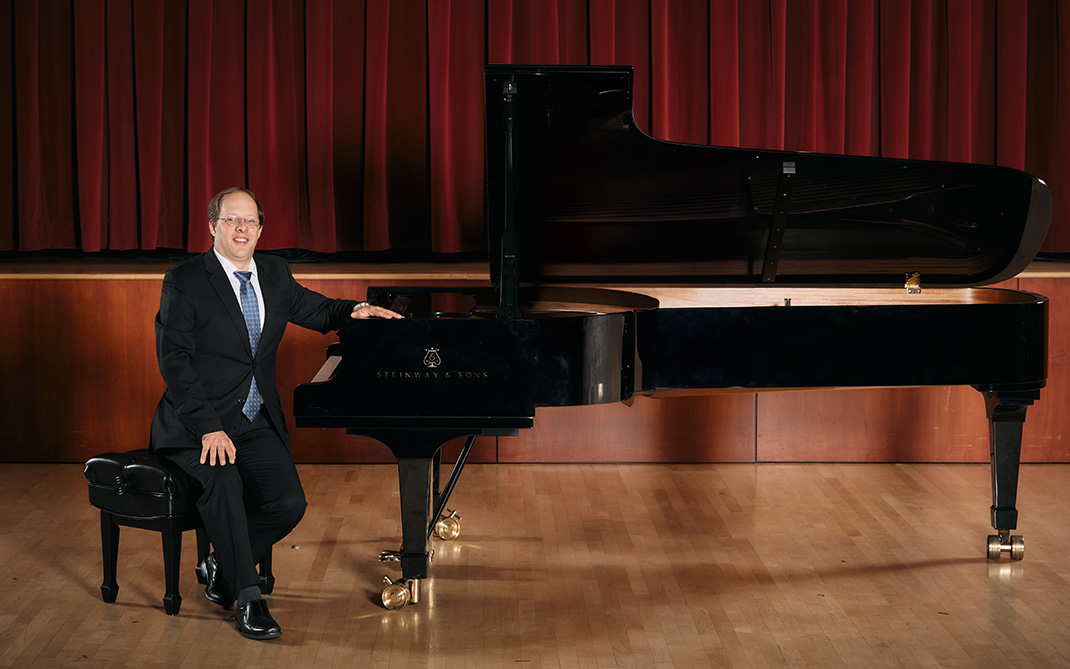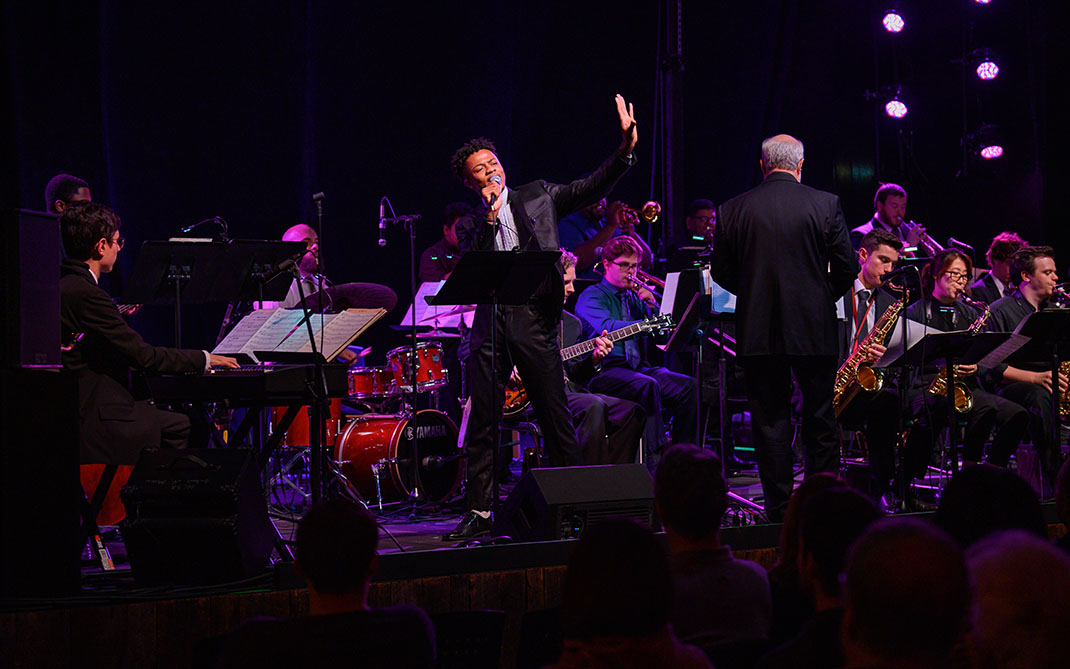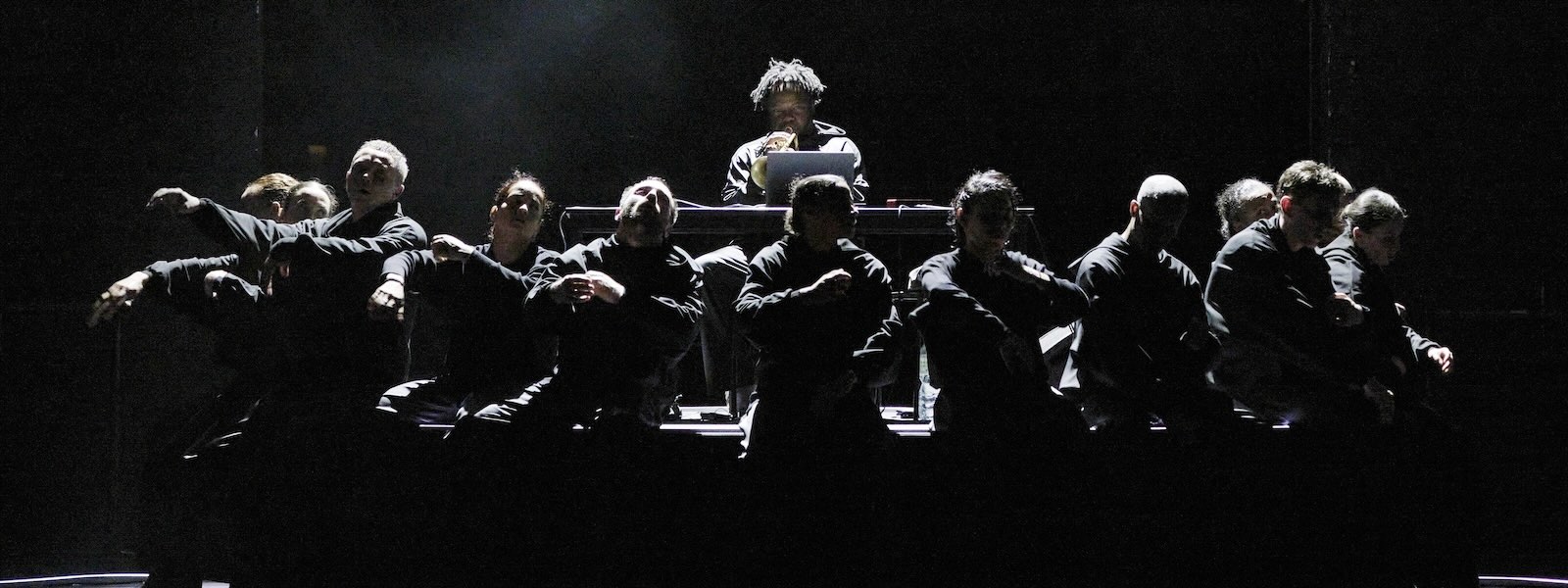Aszure Barton
Listen to the interview on Apple, Spotify, or your listening platform of choice. Captioned interviews are available on YouTube.
The views and opinions expressed by speakers and presenters in connection with Art Restart are their own, and not an endorsement by the Thomas S. Kenan Institute for the Arts and the UNC School of the Arts. This interview has been edited for length and clarity.
On January 26 of 2024, San Francisco Ballet premiered a commissioned work by Canadian American choreographer Aszure Barton. It was titled “Mere Mortals” and explored the science and ramifications of AI through the ancient myth of Pandora. With a brand-new score by world-renowned British electronica composer Sam Shepherd, aka Floating Points, and video and sound design by Barcelona-based Hamill Industries, “Mere Mortals” was a big gamble for new artistic director Tamara Rojo as she closed out her first season with the Ballet.
It paid off. Not only was “Mere Mortals” a hit with critics, with the San Francisco Chronicle calling it “a passionate success,” but it also proved to be a box-office bonanza, so much so that San Francisco Ballet brought the production back to the stage just three months later for several encore performances. Perhaps more importantly, many in the audience were first-time ballet-goers, many of whom saw the piece more than once.
In this arts climate when so many dance companies are struggling to get even their regular audiences back in the door, what was it about “Mere Mortals” that made it such a hit? In this interview, Aszure opens a window into her choreographic practice and how it may have contributed to an event equally invigorating to her dancers and her audience.
Aszure is the artistic director of Aszure Barton & Artists, which she founded very early in her career as a creative outlet for the collaborative and anti-hierarchical instincts she’d had to repress in her dance education. Two decades later, Aszure Barton & Artists, which includes a core staff of creative collaborators, has created work all over the world with a wide array of artists and institutions, including Mikhail Baryshnikov, Nederlans Dans Theater and Alvin Ailey American Dance Theater. Aszure is currently the choreographer in residence at Hubbard Street Dance Chicago and is also developing a new piece in partnership with trumpeter and composer Ambrose Akinmusire.
Choose a question below to begin exploring the interview:
- Could you talk about what hierarchies you’ve broken down in dance? How do you think that’s affected your aesthetic and your work?
- What has happened when you have worked in ballet companies that are very comfortable with existing structures? Have there ever been moments of tension or friction? How do you work through those?
- Have you seen noticeable changes in how women choreographers are regarded by the field? What do you think has yet to be done to achieve parity?
- In the world of dance, how does patriarchy live in ways that a lay person might not immediately recognize?
- What do you think was the magic sauce that made “Mere Mortals” happen? Is it spectacle that brings people in? How do you get audiences to become lifelong fans of the artform?
- You’ve struggled in the past with crippling anxiety … At what point did you feel comfortable sharing that about yourself? What could be changed so that artists in dance can feel more supported through that kind of mental health crisis?
- What current or upcoming project is really occupying most of your mind space right now?
Pier Carlo Talenti: One of the things that sets you apart from many choreographers is that you’re breaking down that hierarchy that you experienced in dance school, let’s say, to start with. Could you talk about how you set about doing that and what hierarchies you’ve broken down? How do you think that’s affected your aesthetic and your work?
Aszure Barton: Well, I have to admit that I work within the hierarchy because I accept jobs and [laughing] I’m delighted to be offered jobs by institutions that function in that way. That being said —
Pier Carlo Talenti: I will ask you later about possible frictions, but for now let’s talk about the way you ideally work.
Aszure: Yes. Well, I think it’s important to create an atmosphere. We spend so much time working, and it is a privilege to be able to work at something that you love, but it is work and it is work and it is something that you spend a lot of time doing. So I strongly believe in creating or trying to at least create an atmosphere that you want to live within. I try to — it’s mostly successful; there’s always friction along the way — not have a hierarchy when I’m actually creating the physical language, even when there’s re-stagings that are happening, meaning that everyone in the space is there learning all of the material and creating the material so that we are all simultaneously creating something together.
I prefer this way of working for many reasons. Recently when I worked with San Francisco Ballet, it was really beautiful to watch people move through uncomfortable moments and come out the other side and be helping and teaching and working in such a democratic way. It was really beautiful.
Pier Carlo: Can you give me an example, for instance, of how in a different setting a dancer might deal with that uncomfortable moment differently than in the room in San Francisco?
Aszure: What do you mean in a different setting?
Pier Carlo: You’re saying that in the San Francisco Ballet, there were democratic instances when you found the dancers moving through these uncomfortable moments and coming out the other end. What did you create in that room that allowed them to do that? What did it look like?
Aszure: Communication, I think. Left in the dark, dancers can be overtaken by self-doubt and questions and feel like we’re withholding information, when I think you’re at the front of the room and/or even if I call it the front of the room, if you’re leading a space, the more information you can share, the better. I’ve experienced the failure of that as well through the process of not doing so and then there being a tension that is created in the space. So I try to be open and honest and communicate every day or as much as I can, as much as possible, if I feel like there’s an uncertainty in the space to call it out. Because I think without uncertainty, we don’t push further at all in anything we do. So letting people know that I too don’t know, and I like to float in ambiguity, and I too don’t know where we’re going, but to trust me. I would hope that people would trust the process, not me actually, but the process. And, yeah, luckily people seem to be open to these ways of working.
Pier Carlo: I was going to ask if your dancers are slightly freaked out to start with.
Aszure: Oh, totally. And I’m freaked out too. And I think that’s it.
Pier Carlo: That’s part of the ambiguity.
Aszure: Yeah, it’s explaining that and also taking myself off of any kind of pedestal. And for principal dancers as well, for them to be able to work with younger dancers and see it also as a privilege, as a teacher, and to share a space in a way through process and realize that it’s not a reflection of their talent or anything like that. Which is hard because we’re all very sensitive. Most of the extraordinary artists that I know are very sensitive, and it’s OK to be uncomfortable. And as I’ve said before, perfectionism is a killer, and I think that we have to accept being messy.
Pier Carlo: How do you think that way of working makes your work better?
Aszure: I think if you have an atmosphere that is delightful and joyful and joins people together that you create beauty, period. I think you feel that. Of course, not every piece is going to be a success, but if you can create a space where 50 people are moving in the same direction, that is a rarity and that is magic. That energy alone is just so, so powerful, to have people facing the same direction and walking in a direction together. And just the act of building and creating together makes them better.
Pier Carlo: My understanding is that in your piece “Mere Mortals,” two of the hierarchies or demarcations you did away were that the roles were not gender-based and also there wasn’t a distinction between the corps de ballet and leads. Is that right?
Aszure: Yeah.
Pier Carlo: Could you talk about getting rid of those demarcations?
Aszure: I think it’s been a long process for me, unfolding into that, over the years recognizing my own choices and my own place within the system and/or taught systems. It was a no-brainer. Of course, there’s going to be certain pieces where you may want to have a group of female-identifying people featured in a piece or whatnot, however —
Pier Carlo: Especially in re-stagings, I imagine.
Aszure: Yeah, in re-stagings. But now I find that so much of what we do is taking on other people’s opinions of things or other people’s choices. We just model ourselves after people before us, and so it’s almost an unconscious choice sometimes. I think being really intentional with who you’re working with is really important to me, and it’s really, really important to allow dancers to make choices. To not limit them was really amazing.
San Francisco was quite recent, so I refer to that. But even if I was perhaps working with one dancer who was male-identifying, there were women that would just come to stand in the space and learn the material, and we would talk about it. This is not limited to how we identify in these spaces. And there, it was such a new way of working for them. I think a lot of people are already doing that, and I don’t take much credit for any of that, but I think it’s important that we continue to in ballet institutions for sure.
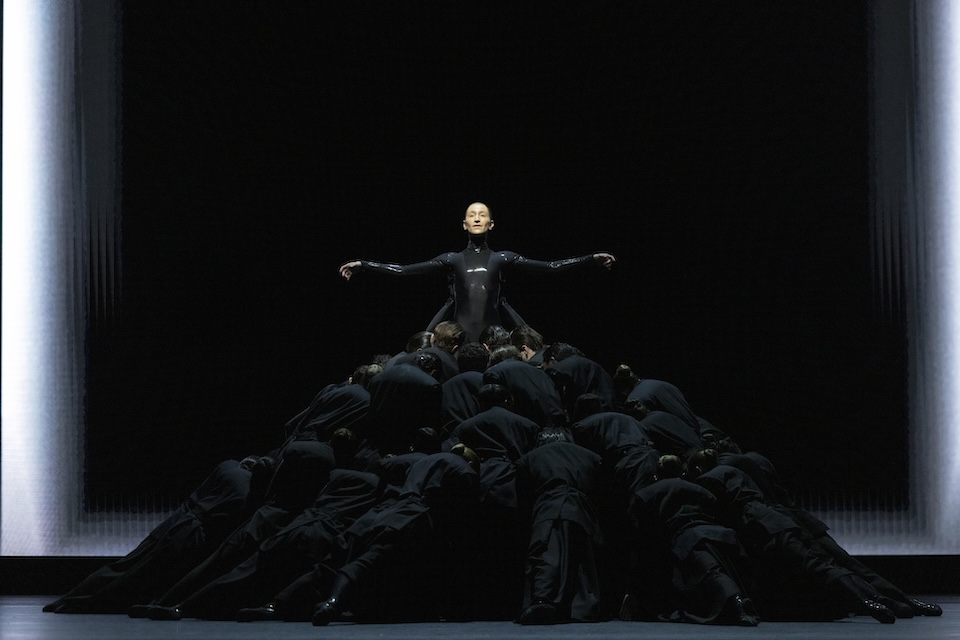
Jennifer Stahl in Aszure Barton and Sam Shepherd's “Mere Mortals” Photo: Chris Hardy
Pier Carlo: What has happened when you have worked in ballet companies that are very comfortable with existing structures? Have there ever been moments of tension or friction? How do you work through those?
Aszure: Yes! [She laughs.] And it’s not just ballet companies!
Pier Carlo: What is it? Tell me.
Aszure: There’s some modern dance companies that I also feel have old systems. Oh yeah, for sure. Can you repeat the question one more time?
Pier Carlo: Sure. Whether you’ve experienced in those companies tension or friction between the way you’d prefer to work and the way they traditionally work?
Aszure: Oh, yes. Not every process is for everyone, so I’m not going to force someone to be in the studio, a part of this process, if it doesn’t work for them. And again, that involves conversations with the director. I’ll generally have a conversation with a certain individual, and in the past, say, if there is a dancer that doesn’t feel that they’re getting the particular role that they want or they feel they deserve, I’ll talk to them and be very open with them about the process. Then if it continues to affect the dynamic in the room, then I have another conversation with them and then see where that needs to go.
But again, I would never want someone to feel forced to be a part of a process that is just not working for them.
Pier Carlo: Since we’re speaking of “Mere Mortals” in San Francisco, I was amazed to learn that it was the first full-length ballet at San Francisco Ballet by a female choreographer.
Aszure: Can you believe it?
Pier Carlo: And also, it was kind of amazing and a little disappointing that one of the reasons why it happened is that finally, there’s a female artistic director there. But still, it’s 2024.
Aszure: Yeah.
Pier Carlo: Since you’ve been working as a professional choreographer, have you seen noticeable changes in how women choreographers are regarded by the field? And also what do you think has yet to be done to achieve parity?
Aszure: Yeah, when I first heard the news, the first woman choreographing for San Francisco Ballet, of course there’s a part of you that’s like, “Yeah, yeah. Fuck, yeah.” And then the other side of it is, “Wait a minute. This is absurd. This is crazy!”
I think there have been some intentional steps for sure to bring more women into leading positions, though I don’t think that necessarily is the only answer. [Under her breath] I think patriarchy can live in many different forms. I am so happy and absolutely psyched that more women are being brought in and that there are more women being given opportunities, but we’ve got a long journey ahead of us because experience is knowledge and it takes time to build.
Pier Carlo: You whispered it, so I’m going to ask you about it. You whispered, “Patriarchy can live in many forms.” So you know I’m going to ask you, in the world of dance, how does it live in ways that a layperson might not immediately recognize?
Aszure: Well, I don’t know if this is going to answer the question directly, because I don’t know if it’s just dance, actually. I think that a lot of people feel like if you’re bringing a woman into an institution or to lead that they naturally have certain values. And I think that power —
Pier Carlo: That they have values that’ll conflict with what the company requires?
Aszure: Or that they too have been born into a certain system so that they end up following the systems of the past. I think patriarchy isn’t just led by men [laughing], and systems of hierarchy aren’t just led by men. I think it’s a human, non-gendered thing. And so I think that’s not just the obvious solution. I think it is dismantling the systems a bit and working together and failing and trying again.
I have so much gratitude when it comes to institutions hiring me and trusting me to come in and to create a certain work for their company. Oh gosh, I have so many feelings around this. I was just going to start to say that I think a lot of people bring choreographers in to create a work that will succeed, and I think that that unto itself is also a very difficult predicament because in order for art to grow, you need to be able to allow artists to fail.
I think in the system in this country it is particularly difficult because we’re trying to survive as a genre or as a language and a form of communication. And money is such a huge factor. I think bringing artists in that you appreciate and respect is one thing, and then expecting them to replicate something you’ve seen before and/or something that will succeed so that they can sell tickets and raise more money for their companies and everything like that is another thing.
I don’t have the answers, that’s for sure, but I know what kind of environments I appreciate working in. Those are generally when artistic directors work together to create an environment that is satisfying for both. I think it is, “Let’s take this risk together, and you do you.” So these are the certain parameters, and if you know them upfront and what the goals are, I think it’s better.
Pier Carlo: “Mere Mortals" was a big success for San Francisco Ballet. It certainly made a big splash, and it achieved any performing-arts institution’s dream, namely bringing people to the art that hadn’t known it before. What do you think was the magic sauce that made that happen? Clearly, your work was great, and you had great artistic collaborators, but as you know, so many performing arts institutions are struggling, especially post-pandemic. Is it spectacle that brings people in? How do you get audiences to become lifelong fans of the artform?
Aszure: Oh gosh, I wish I knew the answer to that!
Pier Carlo: [Laughing] You don’t?
Aszure: [Laughs] No.
Pier Carlo: That’s too bad.
Aszure: I think Tamara Rojo is a powerful, amazing woman. I’m really grateful for her trust in me and her belief in my work. I feel it. I feel the support and also the push. I think that she has a lot of courage, and it has not been easy for her to go in there. She has really been guiding and teaching and implementing what she believes. And I think that’s why it’s important we have people like her and partners that are like-minded in some ways, not always but in some ways. I think she’s done an amazing job at that and an amazing job at realizing from the beginning that not everyone is going to love her.
I think that that’s where she and I align. It’s taken me time to get there. When I was younger, the source of a lot of my anxiety was people-pleasing and/or thinking that certain people had the right opinions or you had to fit inside of somebody else’s likes. Over time I realized that that’s just not true. You have to have fun, and you have to just keep returning to you, to what you believe in. Of course, there are just tons of people that have amazing wisdom, but really to do what makes you feel good, because people will not like you. She’s really, really amazing.
She brought myself and Sam Shepherd together. I didn’t know his music before, and she orchestrated that coming together. She’s very smart, and he has a huge, very specific following that she was curious about. She likes the force behind my work and felt that us coming together was a good match. And our collaborators too. I brought my team, and he brought his team, and luckily we all got along. It was not easy. Actually it was a test of the ego of, “OK, what should I hang onto, and what can I let go of? What do I need to fight for in this moment, and what can I let go of?”
We also had some time, which was really nice. I had suggested to work in residency before, and Tamara made that happen. It’s now something that she really feels is fruitful for choreographers, to have some research time before.
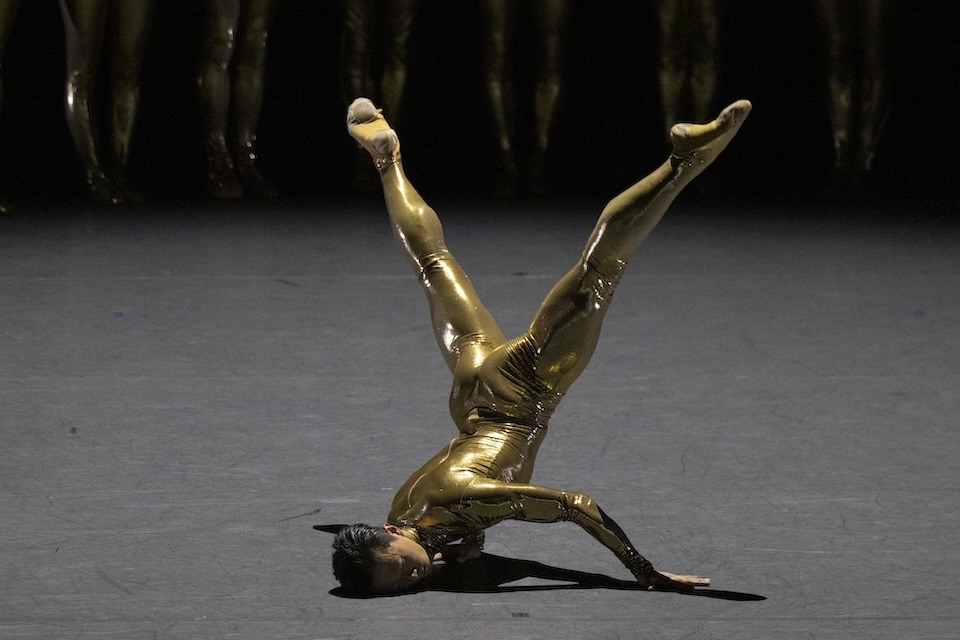
Wei Wang in Aszure Barton and Sam Shepherd's “Mere Mortals” Photo: Chris Hardy
Pier Carlo: Oh, I see. Because usually a choreographer would just be brought in to do the choreography, stage the work.
Aszure: Oh yeah.
Pier Carlo: You had a residency, which was research and hanging out.
Aszure: Yeah. Generally, Aszure Barton & Artists, my crew, is that. No matter what project I’m working on, I am working with my crew in some way. I always bring in a couple of collaborators as dancer collaborators, creative collaborators, and then the design team and the musician.
Not all of them will be involved in every project that I do, but some of them will always be involved in projects that I do. They’re like threads that keep coming back together. We go apart, come back together. In the past with ballet companies, the structures and time are so limited that ... . Well, it depends on the company, if they have varying budgets and things like that, I should say. But often you go in, and you have very limited time, and they expect you to make something fabulous in a very short amount of time.
What I’ve learned over the years is — and I’ve done it for many, many, many years now — is to keep my process going outside of that so that when I go into these institutions, I already have a body of language and/or work that is a continuum so that I don’t get out of practice and also that we can go deeper with people that we build relationships with.
Pier Carlo: I see. But generally then you’re doing that on your own time, on your own dime.
Aszure: Yes, and then boom-boom-boom. Exactly.
Pier Carlo: So what Tamara gave you was actually room —
Aszure: Two weeks. I think we had a week or two weeks of actually being in San Francisco. She brought the team there. We got to jam, we got to be in a space, and there was no expectation, which is a rarity.
Pier Carlo: I think I always assumed, especially with a new dance work, that that always happened, but I’m clearly wrong.
Aszure: No, it doesn’t! It does not.
Pier Carlo: I come from the theater world where you always do workshops before you mount a play. It should become par for the course in dance, it seems, but it’s expensive.
Aszure: It should be. And so that’s why I’ve created it on my own. [She laughs.]
Pier Carlo: I see, right.
Aszure: Yeah. Because it’s absurd to think that someone can come in and — sometimes you’ll come in and make something OK — really make something meaningful. I think you want some time, particularly when it is people who haven’t worked together before and who are all very well-versed in their forms but you don’t know: “How are we going to make this thing work? How are we going to interact? How are we —"
Pier Carlo: Find a common language.
Aszure: Yeah. “What do we like, or what do we not like? And how do we navigate opposition?” Sam and I definitely didn’t agree on all things, but it’s making space for each other. And it was really lovely.
Pier Carlo: One thing that surprised me when I was learning about you was … . I’d always assumed that someone who creates a company so young and has such a successful career has her S-H-I-T altogether.
Aszure: Oh, no.
Pier Carlo: But you’ve been very honest speaking about the fact that you’ve struggled in the past with crippling anxiety, though you have developed ways to manage it. At what point did you feel comfortable sharing that about yourself? What could be changed so that artists in dance can feel more supported through that kind of mental health crisis?
Aszure: Oh, gosh.
Pier Carlo: That was a lot of questions I threw at you.
Aszure: No, it’s OK. I am at a point in my life that I am just so happy that I have ... though I moved through much of it on my own through sheer will and I probably could have asked for help more, I am just so happy that I don’t have the level of anxiety that I have had in the past and that I know how to navigate certain moments. That feels so good. I try to lead my days with that because it is debilitating and it is scary to move through the world in that way.
I think for myself, I realized that a bit of it came from narcissism, which was getting so wrapped up in my own mind that I wasn’t able to see and listen and hear others. I’m sure it’s something that is present for sure and something I’ll have to recognize as I move forward always, but the level of it has changed so much. To realize that I need and want to be able to have honest, genuine connection has really helped me.
So there’s another intimate little story. A few years ago during the pandemic, I had this wonderful dog named Tumo. He was 17 years old, and when I was dealing or moving through a lot of anxiety, I leaned into him. He had some troubles as well, and so we kind of helped each other. I traveled everywhere with this little guy. During the pandemic, he got very ... he was very old, but I recognized that I was a lot stronger and a lot more courageous than I had recognized in the past, and I was able to hold him as he died. This was something that I think I feared my entire life. I think that we hold onto things and structures and systems for safety and control, and again it brings us back to that sense of power and being at least in control of something. In that moment, everything shifted because I knew that it was best for him for me to let go. Though it was the most difficult thing I’ve had to do, it was the most beautiful and the most transformative.
In that moment, my relationship to my work completely shifted. I would isolate myself before, and because of being hurt in the past and these ideas around attachment and being loved. When you’re making work, it is already so vulnerable, so the relationships around you are a sense of security. But you need to or I would say that one benefits from allowing people to go. I realize in those moments of weight, the structures that I have created are actually helping me, and I get to have these amazing relationships that I get to move in and out of all of the time and practice that letting go.
That changed my relationship with anxiety. That changed so much. I get to have these heart-to-heart relationships with dancers, artists, collaborators. What better life than that? I get to create with people that I really love. I’m always practicing it because I think as a director you have to have some kind of control otherwise things are a mess. But that dance between control and letting people be in control of their own lives is also something. Let people be where they are and then they’ll show up if they want to, is something that I really am learning. I was going to say I’ve learned, but I am always in the practice of learning. And it’s great because it frees you to have more fun.
Pier Carlo: Yes, fun is a good antidote to anxiety, always.
Aszure: Oof, it is like the antidote. And pleasure.
Pier Carlo: And speaking of fun and pleasure, finally, what current or upcoming project is really occupying most of your mind space right now?
Aszure: Oh, gosh. Two, a balance of the two worlds, which is really nice. I recently created a piece called “Bend” with my own crew or I should say our crew, Aszure Barton & Artists, and with trumpeter Ambrose Akinmusire. I have never met someone creatively who aligns in some ways that I don’t ... . I have no idea, I cannot fathom how he creates what he creates, but it just folds into what I do so beautifully and challenges me in ways that I can’t express my gratitude for. So I’m very happy about that. We challenge each other, I think. That’s one project that is bubbling and growing, and we’re going to be touring, which is going to be very exciting.
Pier Carlo: So you already have a touring schedule?
Aszure: Well, it’s being created now, and I love building relationships with different directors who believe in my work and who ask me to return. I think that’s something that’s very, very, very special.
Oh, there’s also a third; I’ll get to that.
I’m really deep in preparation for a new work that I’ll be creating for Hamburg Ballet. There’s a new director named Demis Volpi, who I’ve worked with before. He’s taken over Hamburg Ballet, which was under the direction of John Neumeier for 51 years. It’s the first time another director’s coming in, and so I’m excited for that change. I have a lot of respect for the past and for John, and I also think that it’s important to bring in younger artists. So yeah, I am deep in that, about to go do some dance research with some dancers on that so I’m prepared, because it’s not a lot of time to create.
Then also I am in residence at Hubbard Street Dance Chicago. There’s a beautiful soul there named Jonathan Alsberry, who I’ve been working with for 18 years. We have the same mindset in that when you work somewhere, that is not your identity. He loves where he works, and he also loves a multitask. And so he comes and goes, he comes and goes, works on other projects, and we both feel that that is just so important for dancers too. I love that. I hope that more directors can allow space for that, for coming and going. I think there is something to be said for dancers that stay in companies for a long time, and there’s also so much learned by getting outside of an institution that you’re working for, for perspective, for building relationships and building your own place.
So Jojo, Jonathan, and I work on projects throughout the year outside and within Hubbard Street, and so I’m going there. And they’re really behind that. Linda-Denise, who is the director, is fantastic. She is open, and she really understands the expansion that we’re trying to create so that it’s not just me, obviously, that goes in there, that there are other choreographers that are coming in and out and that we trust each other and we trust that we’ll go away and come back. I have a three-year relationship with them.
Pier Carlo: Wow. That feels revolutionary from Hubbard Street.
Aszure: Yeah. I feel like it’s necessary because dancers are also ... without the dancers, what do we have in dance? They’re often, I think, not heard and seen and recognized. Often the choreographer, the director, is making sure we’re listening to what the dancers’ needs are and also guiding and living by example. I think to allow dancers to join other institutions is really important. That crossover of community and building communities so that we’re not isolating ourselves as an individual company so much.
I feel like I’m the thread a little bit, in a way bringing these places together. And I love leading. I’m open to things shifting and changing in my career always, but I feel like I’m in a place of deep privilege to be able to do that. It’s not always secure, and floating is challenging or can be, but it’s really nice when you can also leave a place because people appreciate the work while it’s happening, to be honest. [She laughs.] And I think it’s hard. I admire directors for their willingness show up every day. Day in and day out.
September 09, 2024
